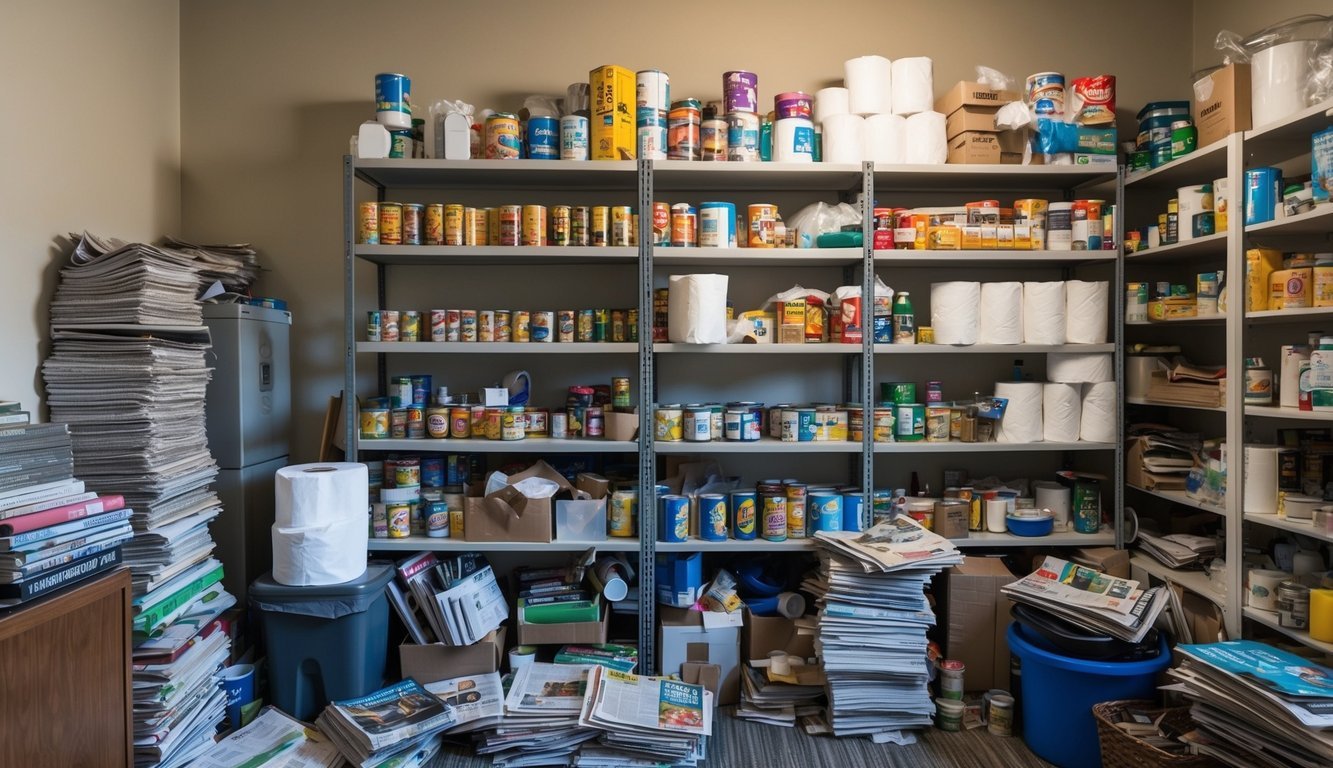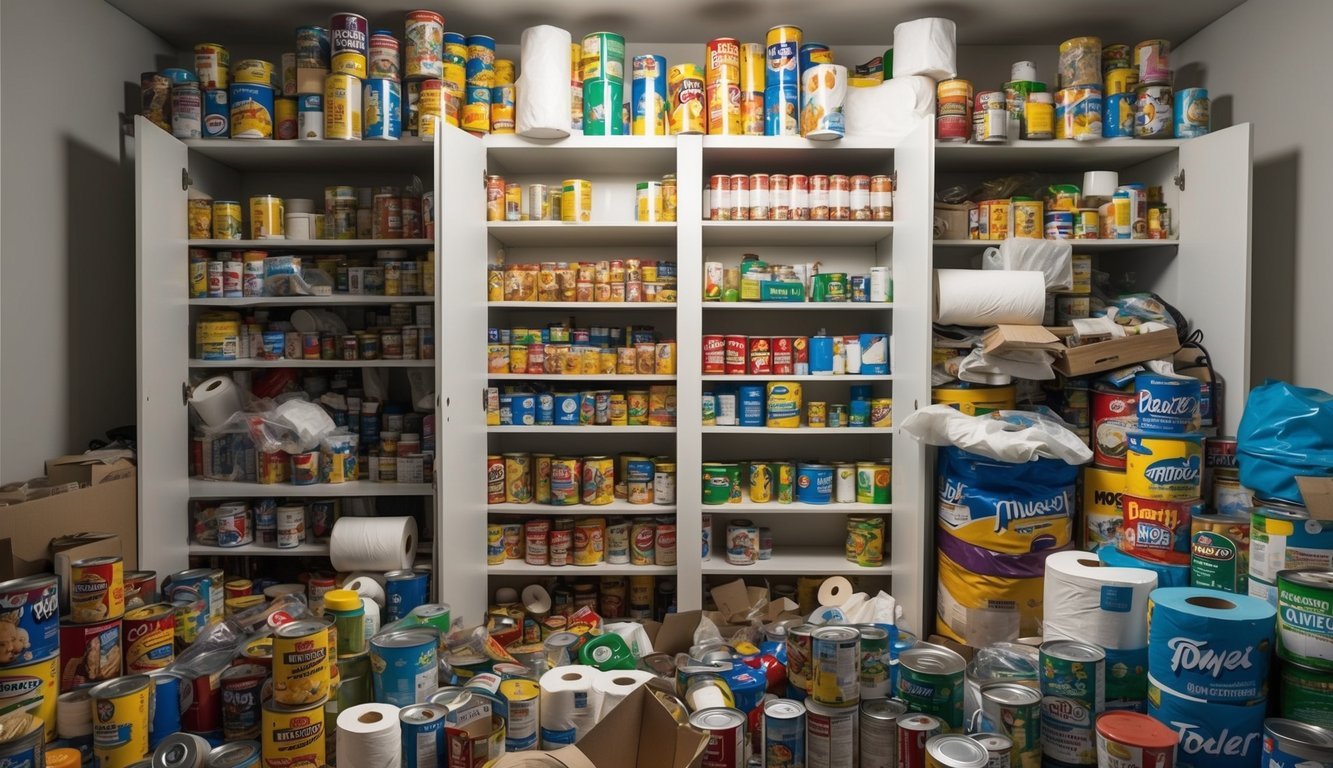PsychNewsDaily Publishers
100 Summit Drive
Burlington, MA, 01803
Telephone: (320) 349-2484
PsychNewsDaily Publishers
100 Summit Drive
Burlington, MA, 01803
Telephone: (320) 349-2484
Hoarding behavior increased during the COVID-19 pandemic, driven by anxiety and fear of shortages, leading to significant impacts on supply chains and vulnerable populations.

During the COVID-19 pandemic, many people felt anxious about the uncertainty surrounding daily life. This worry led some individuals to stockpile essential items, like toilet paper and cleaning supplies, as a way to feel more in control. People with a hoarding personality often respond to crises by accumulating items to manage their fears and anxieties.
The drive to stockpile during the pandemic is not purely about a need for physical items. It reflects deeper trends in behavior, where fear of shortages pushes some to gather more than they actually need. Research indicates that those who tend to hoard may struggle with anxiety and seek comfort in their possessions.
While panic buying became a common sight, it raised ethical concerns as well. When one person grabs an extra pack of toilet paper, it can mean another family goes without. Understanding these behaviors sheds light on the human response to crisis and helps us navigate our shared experiences during tough times.

Hoarding behavior can stem from several psychological traits. Two significant aspects are diligence and perfectionism, along with emotionality and conscientiousness. Understanding these can shed light on why some people stockpile items during crises like the coronavirus pandemic.
Diligence often leads to a strong sense of responsibility. Individuals who are diligent may worry about future shortages. This concern can drive them to stockpile items, believing they are being prepared.
Perfectionism plays a key role as well. Perfectionists may feel they need to have everything organized and in supply. They can become anxious when faced with uncertainty, pushing them to accumulate resources. This combination of diligence and perfectionism leaves them feeling more in control, even if it leads to excessive hoarding.
Emotionality can increase stress and anxiety, especially during tough times. People with high emotional sensitivity may feel overwhelmed by the crisis. They might hoard items to cope with their feelings, thinking they need to ensure safety.
Conscientiousness, like diligence, involves being careful and organized. Conscientious individuals want to do the right thing. During a pandemic, this may lead them to stock up, believing they are acting responsibly. They may struggle to let go of items, fearing they might need them later. This blend of emotionality and conscientiousness can create a strong urge to hoard.

Stockpiling during the coronavirus crisis had significant effects on supermarket supply and the most vulnerable populations. Understanding these impacts is essential to grasp how stockpiling behavior influenced the availability of goods and the well-being of those in need.
Supermarkets faced unusual challenges due to stockpiling. Many shoppers rushed to buy essential items like toilet paper, leading to empty shelves. This increased demand outpaced supply, causing shortages.
To manage this, supermarkets implemented buying limits. They restricted the number of items each customer could purchase. This helped ensure that everyone had access to necessary goods, even if supplies were low.
The sudden spike in demand also prompted suppliers to increase production. However, it took time to catch up, leaving some items out of stock for weeks. This cycle of demand and supply created stress for both supermarkets and consumers.
Stockpiling negatively impacted vulnerable groups, particularly older people. These individuals often rely on regular grocery visits and struggled to find basic supplies.
With shelves emptied, they faced difficulties accessing toilet paper and food. Many older adults felt anxious and helpless during this time. Their health and well-being were at risk due to limited access to essentials.
Additionally, families in need also experienced shortages. Stockpiling made it harder for them to acquire necessary supplies. This situation highlighted the importance of considering how individual behaviors can affect the community, especially during a crisis.

During health crises, consumer behavior often shifts significantly. Many individuals feel anxious and uncertain, leading to changes in how they shop. This section explores panic buying patterns and the coping mechanisms that emerge during such times.
Panic buying occurs when consumers rush to buy large quantities of items in response to fear and uncertainty. During the coronavirus crisis, this behavior intensified. People stocked up on essentials like food, toilet paper, and cleaning supplies.
Several factors fueled this pattern:
This aggressive purchasing behavior disrupted supply chains, leading to shortages and creating more panic among shoppers.
For some, stockpiling goods became a way to cope with stress. Items in their homes became symbols of safety and control during uncertain times.
When people faced a health crisis, they often turned to these behaviors:
These factors transformed consumer behavior, making simple acts of shopping deeply intertwined with emotions and societal influences.

Addressing hoarding behaviors during crises like the coronavirus pandemic requires careful strategies. Focusing on education and the role of communities can help manage this issue. By promoting awareness and offering support, individuals can be guided toward more balanced behaviors.
Education plays a key role in curbing hoarding tendencies. Public messages should focus on the importance of sharing resources rather than stockpiling them.
Key Messages to Promote:
Engaging media campaigns can reinforce these messages. They can utilize social platforms to reach wider audiences and encourage responsible purchasing habits.
Volunteers are vital in preventing hoarding by offering support and resources. They can engage in local efforts to educate community members about sharing supplies.
Ways Volunteers Can Help:
Local organizations can team up with volunteers to ensure that community needs are met without unnecessary stockpiling. By fostering a spirit of cooperation, communities can combat hoarding behaviors effectively.

As communities begin to recover from the coronavirus crisis, there are important points for those who stockpiled supplies to consider.
Self-Reflection: Individuals should assess their stockpiling behavior. Understanding the reasons behind their actions can help them respond better in future crises.
Conscientiousness: This trait can lead to better planning and decision-making. Being aware of one’s tendencies can improve how one prepares for emergencies without unnecessary stockpiling.
Organization: Keeping supplies organized can reduce anxiety and make resources more accessible. It’s helpful to create an inventory system to track food and other essentials. This can prevent overbuying and ensure that items are used before they expire.
Engaging Volunteers: Communities can benefit from volunteer programs focused on sharing resources. Working together can foster a sense of unity and reduce individual stockpiling. Volunteers can help distribute items to those in need, ensuring resources go to everyone.
Education and Awareness: Hosting workshops can educate others about smart shopping habits. Sharing best practices can decrease panic buying and hoarding in future crises.
These considerations can guide individuals as they navigate life after the pandemic. By fostering conscientiousness, organization, and community spirit, it’s possible to create a healthier environment for everyone.

Hoarding behavior during the COVID-19 pandemic raised many questions. People wondered why certain items were stockpiled, how this behavior affected supply chains, and what steps could be taken to improve access to necessities.
Many individuals hoarded specific items due to anxiety and fear of shortages. Items like toilet paper, hand sanitizer, and non-perishable foods became targets. The perception of threat led some to stockpile these goods, as they wanted to feel secure during uncertain times.
Hoarding created significant challenges for supply chains. The demand for certain products surged, disrupting normal distribution patterns. Retailers struggled to keep shelves stocked, leading to shortages that affected many consumers.
Psychological factors like anxiety and fear play a big role in hoarding. Individuals may feel the need to control their environment during crises, leading to excessive buying. In some cases, those with hoarding disorder may react differently than others to stressful situations.
Communities can focus on education and resource sharing to prevent hoarding. Clear communication about supply levels can help reduce panic buying. Implementing limits on certain items can also ensure everyone has access to necessary goods during emergencies.
Retailers responded to increased demand by implementing purchase limits on high-demand items. They also worked to restock shelves quickly. Many stores enhanced their online shopping options to accommodate changing consumer habits.
The pandemic shifted consumer buying habits significantly. Many people became more aware of the possibility of shortages, leading to anxiety-driven purchases. This change in mindset affected how individuals approached shopping. They often prioritized essentials over other items.